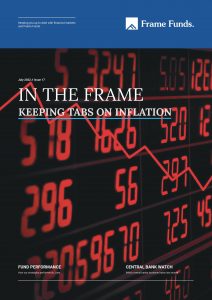Once again, global share markets swung around on news of potential and realised rate increases, and expectations for slowing global economic growth. Locally, the RBA increased interest rates by 50 basis points, as Governor Lowe reiterated that they would do whatever it takes to reduce inflation back to their target range. US inflation continued to accelerate. It printed a reading around 9%.
Central bank watch
Central Banks continued to take action to contain inflation by increasing interest rates. June saw the following central banks increase interest rates; Bank of Canada raised 50bps to 1.50%. Reserve Bank of Australia, increased 50bps to 0.85%. Reserve Bank of India rose by 50bps to 4.9%. US Federal Reserve increased 75bps to 1.75%. Bank of England increased 25bps to 1.25%, while Norges Bank rose 50bps to 1.25%.
Tough markets
To put the first half of the year into perspective, this has been the worst start to the year for equities since 1970. For a balanced 60/40 portfolio (60% equities/40% bonds), it has been the worst start to the year, ever.
Systematic risk management
One of the key things that we have built here at Frame Funds, is systematic risk management. What that means is that if we experience a period of extreme downward movement in global equity markets, we will exit the market as these risks increase.
By making risk management systematic, we ensure that we systematically get taken out of the market when the market loses momentum. Our trend following strategies will only re-enter new positions when the market momentum returns. Currently our cash balances are sticky, until the market gains momentum once again.
Portfolio performance
During June, both strategies suffered, as markets broke to new lows and volatility continued to expand within global equity markets. The Long Short Australian Equity declined by -4.81%, while our global macro strategy declined by -7.19%. Both strategies outperformed the S&P/ASX 200, which was down -8.92%.
Both strategies have experienced periods of expanded volatility as markets have whipsawed, in response, they have reduced their equity exposure. This has increased their cash holdings, which puts both in a positive to take advantage of upcoming opportunities.
Top equity contributors for the Frame Long Short Australian Equity Fund (FLSAEF) were Atlas Arteria Group (ASX: ALX), Computershare Ltd (ASX: CPU) and the Lottery Corporation Ltd (ASX:TLC). They contributed +0.41%, +0.21% and +0.06% respectively.
Largest detractors for the month were National Australia Bank (ASX: NAB), Whitehaven Coal (ASX: WHC) and Origin Energy (ASX: ORG). They detracted -0.44%, -0.42% and -0.41% respectively.
For the Frame Futures Fund (FFF), Commodity and Currency investments rose by 0.29% and +0.22% respectively. Fixed Income investments were flat, while Equity investments declined by -7.51%.
Wrapping up
Going through a period of market volatility is never enjoyable, however, it is an unavoidable part of investing in equity markets.
Both our strategies have experienced drawdowns and are currently at the outer limits of our back-tested drawdown ranges. We have increased our cash holdings pro-actively, to put us in a position to benefit from the opportunity set we currently see.
We are working harder than ever to improve returns, and we continue to focus on all the things that are within our circle of control.
We continue to focus on our research processes, executing our short and long reversion strategies, refining our trend following strategies, further research on strategy improvements, and tightening our risk management systems.
In my view, if we continue to focus on the things we can control (like we did during the COVID induced sell-off), we will come out of this period much stronger than when we entered.
Thank you for your support during these testing times. Our team is working harder than ever to provide the best possible outcome for our investors through this period.
If you would like to discuss any of these points, please email me at hue@framefunds.com.au or call our office on 02 8668 4877.
Download the full report by clicking the image below.
